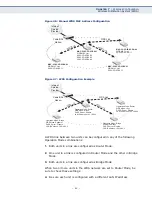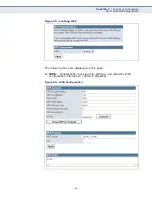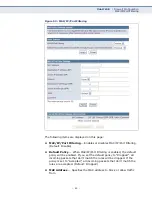
C
HAPTER
7
| Wireless Configuration
WLAN Security
– 76 –
◆
WEP-AUTO
— Allows wireless clients to connect to the network using
Open-WEP (uses WEP for encryption only) or Shared-WEP (uses WEP
for authentication and encryption).
◆
Encrypt Type
— Selects WEP for data encryption (OPEN mode only).
◆
Default Key
— Selects the WEP key number to use for authentication
or data encryption. If wireless clients have all four WEP keys configured
to the same values, you can change the encryption key to any of the
settings without having to update the client keys. (Default: 1;
Range: 1~4)
◆
WEP Keys 1 ~ 4
— Sets WEP key values. The user must first select
ASCII or hexadecimal keys. Each WEP key has an index number. Enter
key values that match the key type and length settings. Enter 5
alphanumeric characters or 10 hexadecimal digits for 64-bit keys, or
enter 13 alphanumeric characters or 26 hexadecimal digits for 128-bit
keys. (Default: Hex, no preset value)
WPA P
RE
-S
HARED
K
EY
Wi-Fi Protected Access (WPA) was introduced as an interim solution for the
vulnerability of WEP pending the adoption of a more robust wireless
security standard. WPA2 includes the complete wireless security standard,
but also offers backward compatibility with WPA. Both WPA and WPA2
provide an “enterprise” and “personal” mode of operation.
For small home or office networks, WPA and WPA2 provide a simple
“personal” operating mode that uses just a pre-shared key for network
access. The WPA Pre-Shared Key (WPA-PSK) mode uses a common
password phrase for user authentication that is manually entered on the
access point and all wireless clients. Data encryption keys are
automatically generated by the access point and distributed to all clients
connected to the network.
Figure 42: Security Mode - WPA-PSK
The following items are displayed in this section on this page:
Security Mode
— Configures the WPA-PSK and WPA2-PSK security modes
used by clients. When using WPA-PSK or WPA2-PSK, be sure to define the
shared key for the Mini Broadband Router and all its clients.
(Default: Disable)
















































